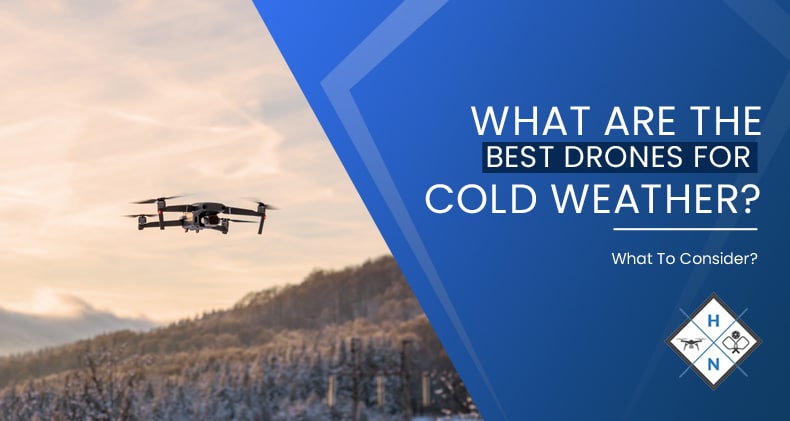Drones are more weather-proof than most people give them credit for. But that doesn't imply you can fly your drone with little to no consideration to the weather outside. Some drones are simply not up for the challenge, particularly when that's in the form of "snow" or "extreme cold".
The best drones for cold weather conditions are the PowerEgg X Wizard, Parrot ANAFI HPV, SwellPro SPRY+, etc. If money is no object and you're willing to go all out on your buy, the $6,000+ HexH2O Pro V2 is worth a look. For people with enough disposable income, it's the perfect all-weather drone.
Manufacturers usually do not make drones to tackle rains or extreme winters because it's risky or could lead to multiple drones coming in for costly repairs during the warranty period. If you'd like to learn more about why drones and cold weather do not mix, the drones that do indeed fare well in winters, and more, keep reading.
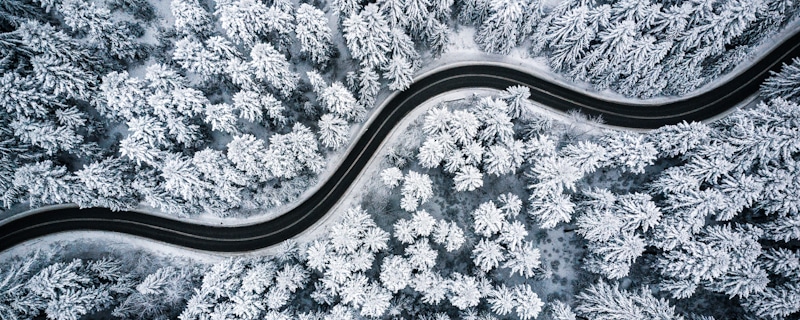
Is It Okay to Fly a Drone in Cold Weather?
It's not okay to fly a drone in cold weather. It's certainly not ideal – which is why even the best drones are not officially rated to offer protection against water, dust, and weather. Like airplanes, drones function the best when the temperatures are warm, the sky is sunny and bright, and there is little to no wind.
Why is it not okay to fly a drone in cold weather? At their core, drones are pieces of different electronics put together – which include:
- Sensors (camera, radar, laser, accelerometer, gyroscope, barometer)
- Power supplies (battery, combustion engine)
- Actuators and motors (electronic speed controllers)
- Computing technologies (systems-on-chip, microcontrollers)
When it's frigid outside or snows, water droplets and ice crystals can form on the drone's exterior, slowly making their way into the drone and wrecking the electronics within.
Then there's also the issue of drone batteries freezing in the cold. Even if the battery does not stop functioning cold turkey, its longevity on a charge will come down significantly when its environment is not adequately warm.
But as alluded to before in the intro, a traditional drone will not die the next moment when you take it out in conditions that are beyond its tolerance levels. There have been anecdotal reports of drones having survived extreme cold despite not being built for the same. This phenomenon can be likened to how smartphones without an official IP rating manage to survive a few splashes of water.
It's just that it's not advisable to take your vulnerable UAVs outside when the conditions are not right. The drone could lose its efficiency, or its lifespan could considerably decrease due to usage in unfavorable environments.
How Cold is Too Cold for a Drone?
It depends on the ideal operating temperature specified for the drone by its maker, which varies across models.
For instance, the ideal temperature range for DJI drones is 32° to 104°F (0° to 40°C). But, as mentioned above, flying a DJI outside of those temperatures is not impossible or impractical. It's just that doing so is not recommended.
If you face issues with your drone due to flying the aircraft in conditions that fall outside its comfort zone, the repairs may not get covered under warranty. In certain rare cases, repairs may not be feasible at all.
The operating temperature guidelines not just apply to the drone but also to the aircraft's remote controller. Not to mention, all measures (discussed below) employed to keep your drone or its battery warm can/should be applied to the remote control as well.
Best Drones for Cold Weather
Since "waterproofing" is not what most drone makers put major focus on (assuming drone flyers will not use their mini aircraft when it's cloudy, dark, cold, and/or wet outside), there aren't too many drones out there with official waterproof ratings. For instance, pretty much all of the drones in DJI's catalog are not "waterproof".
Therefore, the following list comprises drones from established manufacturers and some obscure brands as well. They may or may not excel at battery life, camera capabilities, flight speed, etc., but they certainly are among the best at handling cold or rough weather conditions.
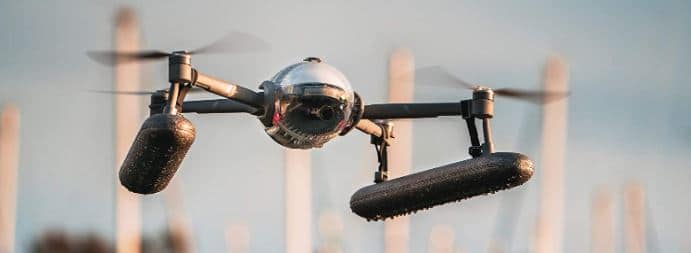
PowerVision PowerEgg X Wizard
The drone market is inundated and dominated by drones that aren't necessarily known for their prowess in cold weather conditions. The PowerVision PowerEgg X Wizard stands out from that crowd. For starters, it has a pretty unusual design for a drone.
The PowerEgg X Wizard is a highly capable and stable drone, thanks to its large propellers. It's an excellent option for people who want the ability to fly their drones in the snow, rain and even land their UAVs on water.
Besides being an all-weather drone, the X Wizard can function as a manually held gimbal camera and as an AI camera that can attach itself to a tripod and be managed with hand gestures. The integrated microphone is a handy addition too.
The waterproof fins and housing do alter flight behavior a tad, but not to the extent of making drone operations difficult or tricky. However, the added protections add to the drone's drag and weight, reducing flight time in the process.
Despite the unusual design, the X Wizard has all the features most drone pilots have come to know and love about UAVs – including mobile app support. And unlike drones that fold for storage and portability, the PowerEgg X Wizard has detachable propeller arms, which makes cleaning the snow easy.

Parrot ANAFI FPV
Initially launched in 2018 without the FPV (first-person view) option, the Parrot ANAFI FPV is a well-designed drone with a 21-megapixel camera that can tilt down and up. Thanks to the high resolution, the camera is capable of 3x lossless zoom. It also supports 4K video recording.
The drone is relatively light at 11.2 oz (320g), but the controller is not, weighing in at more than three pounds. The battery charges using a USB-C charger, and it's capable of fast charging – 60% quicker than traditional USB-A 5W chargers. In cold weather, the quick charging facility comes in quite handy.
Though Parrot doesn't particularly talk about ANAFI's resilience and durability in the snow, many people have used the drone in extreme cold and have had no significant issues with it. The promised flight time of 25 minutes does take a hit, and the batteries do tend to get cooler quickly, but nothing catastrophic has been reported.
The ANAFI FPV is loved for its "Follow Me" mode, which works pretty well even in chilly winters. The drone can move forward awfully close to snowy surfaces, affording you those cinematic shots.
Though not your typical waterproof drone, it's pretty capable of handling rough weather. It's safe to say the ANAFI strikes the right balance between toughness and performance.

SwellPro SPRY+
The SwellPro SPRY+ is among those few drones that can completely submerge in water. Its remote controller is waterproof too. The drone can stay submerged for a brief period like a submarine, fly at more than 40mph (64kmph), or float on water bodies like a boat.
The integrated camera is capable of 4K video recording at 30FPS and shoots pictures using the 12-megapixel sensor. The drone can also transmit video signals wirelessly to the monitor that comes integrated into the remote control.
The SPRY+ is not the most popular drone out there. But it's arguably the easiest quadcopter to work with. You just need to power it on and turn on the remote control – after, of course, installing the antennas for video and the transmission telemetry. Such ease of use and swiftness is something you'll truly appreciate in the snow.
As far as flight performance goes, the drone hovers quite admirably. Its maximum flight time is around 17 minutes, and it can fly at a speed of around 45MPH (72.4 kph). Not to mention, the SwellPro SPRY+ is one of those very few drones you could take out kayaking and surfing and not worry about how it'll fare.
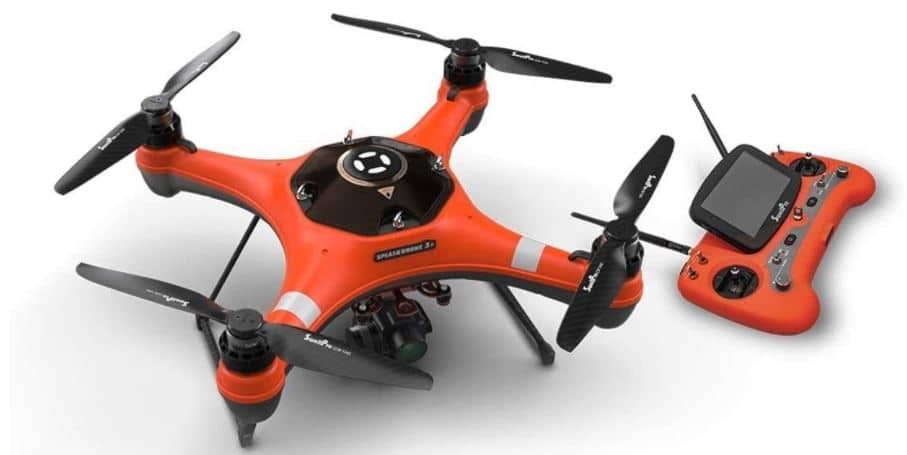
SwellPro Splash Drone 3+
The Splash Drone 3+ is another waterproof camera by SwellPro. The drone is relatively barebones – for instance, it doesn't come with a built-in camera. But you can outfit it with a waterproof drone camera of your choice for filming or when boating or fishing.
The 5,200 mAh battery offers a maximum flight time of more than 20 minutes, and it also sends a warning signal when it's running out of juice. It can fly at a speed of up to 40.3mph (65kmph).
The entire body is made of reinforced ABS material that ensures a waterproof seal. The drone has an official IP67 waterproof rating. It is also corrosion-resistant and can be flown in both rain and snow.
The remote control offers a clear and bright view of the drone footage live, thanks to the embedded screen. It's easy to use and feature-packed – comprising ATTI, GPS, intelligent cruise flight mode, etc. The knobs are pretty flexible and responsive too.
You can also use your smartphone or any GPS-enabled tablet to control the drone. The SwellPro Fly mobile app offers even more innovative flying modes, making your drone's flight easier.
Perhaps the most underrated feature is SAR live-saving that lets you search for distressed or missing people.
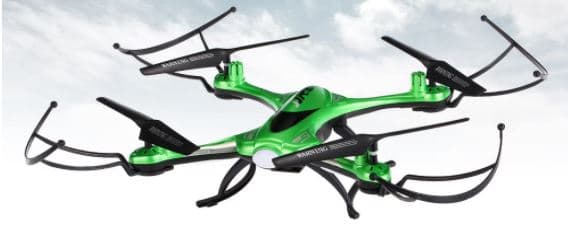
Goolsky JJRC H31
The JJRC H31 by Goolsky is a "headless" drone that offers multi-direction flying capabilities. It's backed by a robust rotor and an all-weather-friendly transmitter. The six-axis gyro tech is a recipe for some concrete action and loads of fun. The "headless" feature denotes you can fly the drone right away without making the typical adjustment required before the first flight.
Goolsky is a relatively new name in the mini aircraft industry, affording you maximum value for the least possible price. The $30 price suggests the manufacturer is hardly making any profit on the drone. Perhaps the objective is to capture market share and popularize the brand and its products.
As mentioned above, the JJRC H31 is very competitively priced. But the price is no indicator of the drone's build and overall quality. The propellers, landing gear, propeller protector, etc., are pretty high quality. They may not compete with the high-end drones' components, but they certainly are not sub-par.
The H31 is quite versatile too. Besides being able to function in cold weather, rain, summer, etc., you can use the drone for various purposes, such as local surveillance, aerial photography, and drone racing.
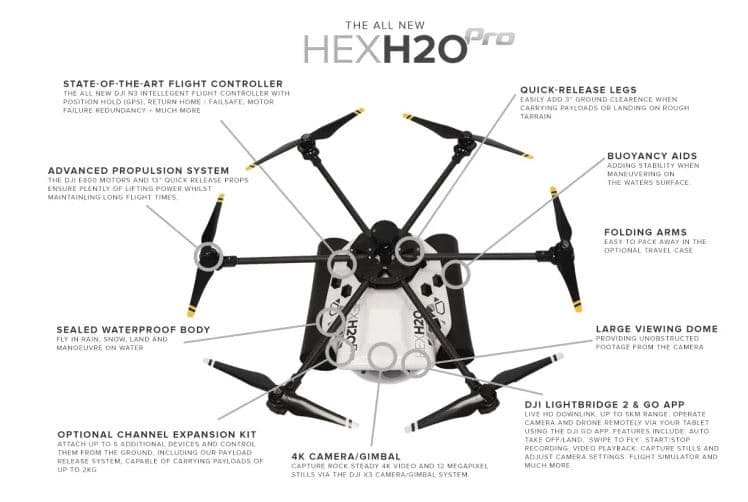
HexH2O Pro V2
The HexH2O Pro V2 (as the name hints) succeeds the original HexH2O. It betters its predecessor in battery life, range, flight time, etc. The flight period, for instance, has gone up to 30 minutes from 25. A 5-minute increase may not sound much, but it makes a tangible difference on the ground when flying the drone.
You can use the HexH2O Pro V2 in pretty much any weather. You may also land it directly on water to capture shots below or above the water. This versatility makes the drone a proper utility tool. It can be used right from on-water industrial tests to search-and-rescue missions and also marine biology.
Unfortunately, the HexH2O Pro V2 is expensive. With prices starting at $6,449, the drone is out of reach of most buyers. Even the few who do have the money and are willing to splurge may think twice before spending that kind of dough on a drone called HexH2O. The HexH2O name, after all, is not as famous or well-known as DJI.
But none of the DJI drones are known for their ability to withstand bad weather. Therefore, if you're looking to buy a drone that can do it all and do them well, the HexH2O is undoubtedly worth taking a serious look.
Flying Drones Not Made for the Cold in Winters
As alluded to earlier, drones purpose-made for cold, snowy weather or even rains usually do not perform well in other aspects. Most people, therefore, look for drones that are solid overall and not necessarily "cold weather champs". This, however, begs the question: Should you limit flying your regular drone to during summer and spring only?
Absolutely not! The ideal conditions for flying a drone in the West are limited or could mean just a few months of flying each year, which pretty much no drone owner would be happy about. But you need to be a bit more prepared and cautious than you would be when flying your drone during the ideal periods of the year.
Here are a few things you should consider doing when or before flying your regular drones in extreme cold:
Make Sure the Batteries are Warm
When batteries go cold, they don't produce the required voltage. Lithium polymer (lipo) batteries undergo chemical reactions to generate power, which can be created only when the battery's temperature falls within a particular range or is at room temperature (68°F or 20°C).
To make sure the batteries are warm enough, keep them in your winter jacket's inside pockets. Your body temperature will help keep the battery warm. Placing them in a bag with hand warmers is also a good ploy.
Also, you could place the batteries on your car's dashboard or any place where it's relatively toasty. Do not put it near the fireplace, however. That's just the other extreme or will damage the battery.
Keep an External Battery Pack Around Always
Regardless of how hard you try, your drone battery will not last in the winter as long as it does during summer. Therefore, it's handy to have a battery pack at the ready constantly. You may use the battery pack to charge your smartphone, controller, or any other device that runs on a rechargeable battery.
Also, make sure you have spare batteries so that you need not wait for the depleted batteries to charge again before resuming the flight. When there are extra lipo cells around, you can swap the exhausted batteries with the fresh ones and continue flying the drone while the used-up batteries rejuvenate.
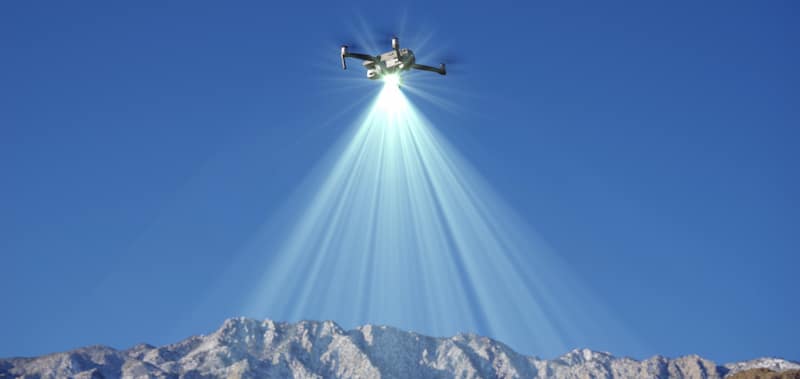
Make Sure the Drone is Relatively Active
When flying a regular drone in the snow, ensure it's not resting or sitting idle doing nothing. As far as possible, keep it engaged so that the batteries and the electronic circuitry continue to stay warm, and there's also no snow build-up.
The drone need not be zooming past to do that. Just keeping it moving or hovering shall suffice. Hovering the drone for a minute or two before setting it on its actual flight is also an effective way to warm up the mini aircraft and check for any early hiccups.
And when you're not using the drone, place it on some landing pad instead of directly on the snow. Direct exposure to the snow from underneath can cool down the battery relatively fast.
The indented portions or the holes where the screws go could get covered by or blocked with snow. And when you take the drone and put it somewhere warm without clearing the stuck-in crystallized ice, the snow will eventually melt, and the left-behind water could enter the drone and wreck the electronic components within.
Keep Your Flights Short
When flying drones in winter, keep the flights shorter than usual. If your drone is capable of a 25-minute continuous flight, for instance, reduce the flying time to 10 minutes. In other words, if the battery is at 50% at any point, abort the flight. The drone's mobile app shall let you in on the battery status in real-time.
Not trying to extract as much run time possible will considerably negate the chances of your drone crashing mid-air or going rogue. Batteries and other electric circuitry can quickly cool down during winter, as stated earlier. It's, therefore, advisable to keep their exposure to cold temperatures as brief as possible.
Each time you break the flight and bring the drone back in, you get the chance to inspect the aircraft, its propellers, feel the drone's temperature, etc. For instance, ice could accumulate on the propellers, causing the drone to malfunction. You'll also be able to take the cold batteries out and replace them with warm, fully charged cells.
Keeping flights short also means not flying the drone too far from its base. The last thing you want is to hike several miles in the snow when something goes wrong with the drone, and it drops out of the sky.
Flying a drone spanning distances is something you may be used to or prefer. But it's highly recommended you strictly indulge in such distant expeditions only during warm weather conditions or when the sky is bright and clear.
Cut Down on the Speed
Based on how cold it is and how warm the battery is, your drone's flight time could vary. But if you're pushing the drone to its limits or flying it at high speeds, the battery will die out a lot quicker.
When your drone moves forward, air flows through the aircraft. The faster the drone flies, the more the amount of air will stream through. And because air is much colder during winter, the cool inbound air will hurt the battery and its performance.
It will also cool down the other components of the drone quickly or excessively, causing major issues. Therefore, it's recommended to cut down on the drone's forward movement as much as possible when flying the aircraft during winters.
It's still not recommended to fly your drones when it's snowing or freezing outside. But if you don't have the no-fly option, the above tips may render the experience less of an ordeal.
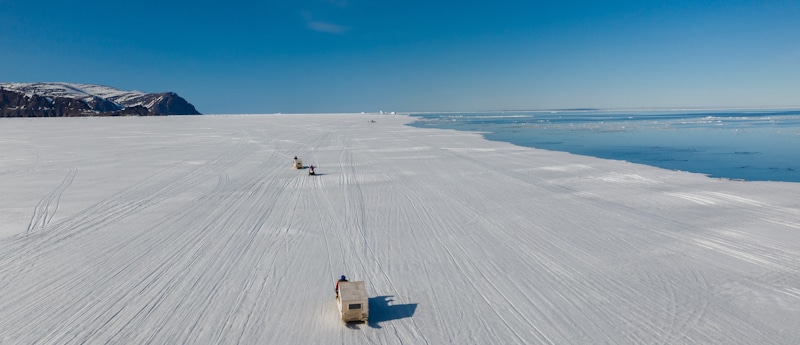
Conclusion
When you're looking to buy a drone for cold weather, it's imperative to look for a waterproof one. That's because winters are not just about freezing temperatures but also the snow, which is essentially crystallized water. When snowflakes rest on your drone's body or permeate the outer shell through some opening, it's pretty much water entering your drone.
If you're sure you don't need a drone that is monsoon-safe (because you don't go drone-flying during monsoons) or has its guards up against snow, look to buy a drone such as the Parrot ANAFI FPV – and not necessarily one that's specially made to be used in the rain or cold weather.
For increased toughness, versatility, and performance in all weather conditions, look at any of the above options.
Shawn Manaher loves to play with new toys and dive into new hobbies. As a serial entrepreneur, work definitely comes first but there is always room for hobbies.

